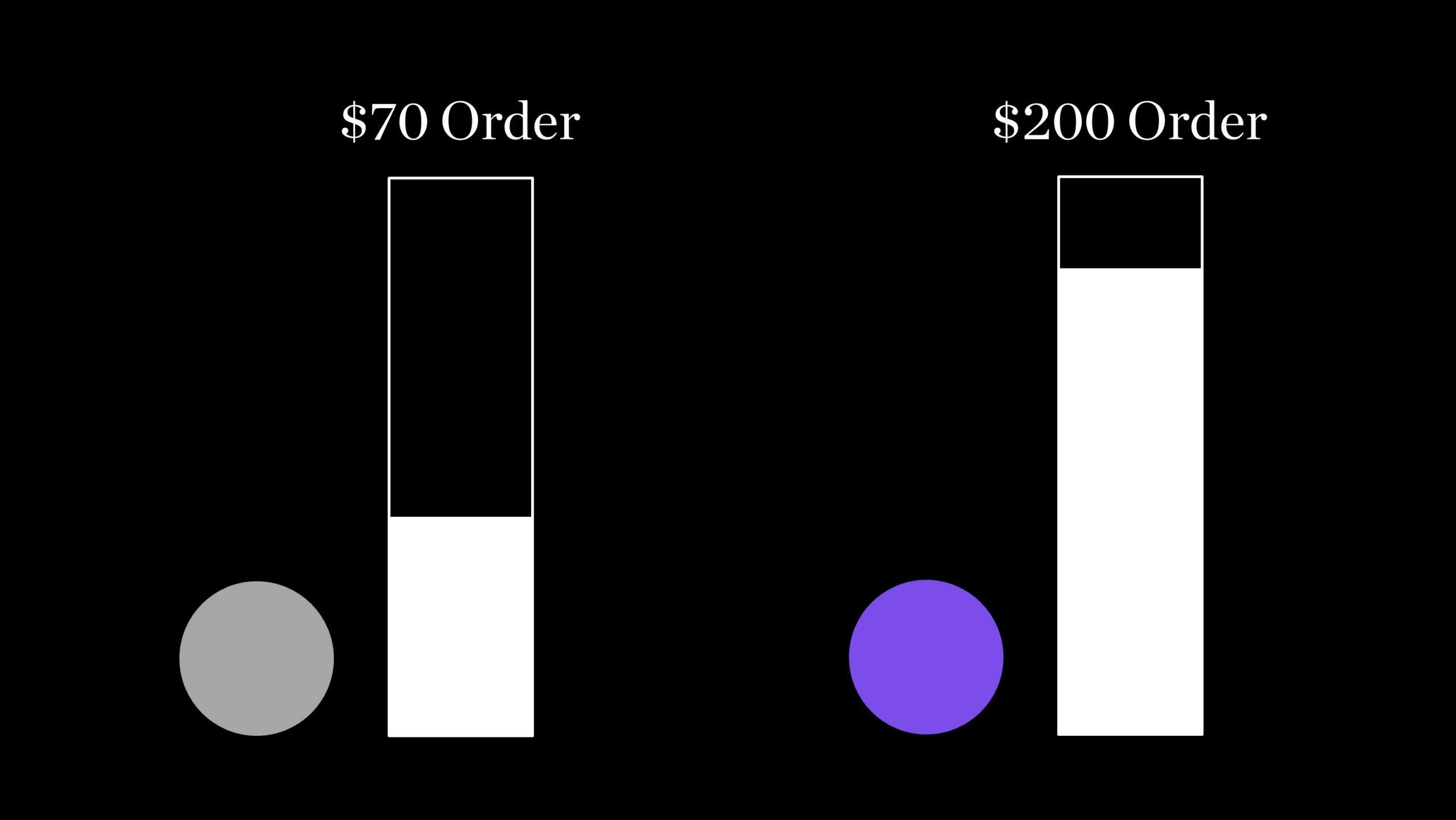Article last updated on August 17, 2021
Most online business owners think that increasing revenue is all about finding more customers. But, this is not the only way to grow.
You can get more value from the buyers that you already have by increasing your Average Order Value (AOV) and Average Basket Value (ABV), as they are sometimes called.
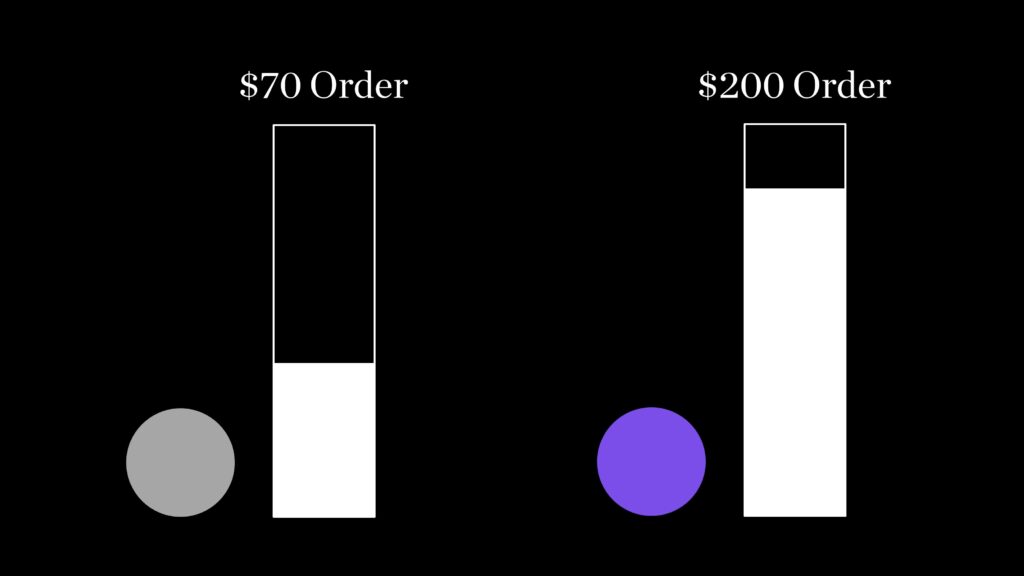
This allows you to grow your business without additional spending on marketing and advertising.
Let’s say you have two customers…
Customer #1 buys the same three consumable items from your eCommerce shop every week.
Customer #2 purchases three different sets of consumable products on a monthly basis.
Which shopper is best for your business? You can not know exactly, because before you can determine which shopper is most valuable for your business, it is important to understand the cost of the items that are being bought, right?
This is where the average order value comes into play.
What is the Average Order Value (AOV)
The average order value, or AOV, is the average amount that customers spend on a single purchase transaction.
It is easy to calculate AOV using this formula:
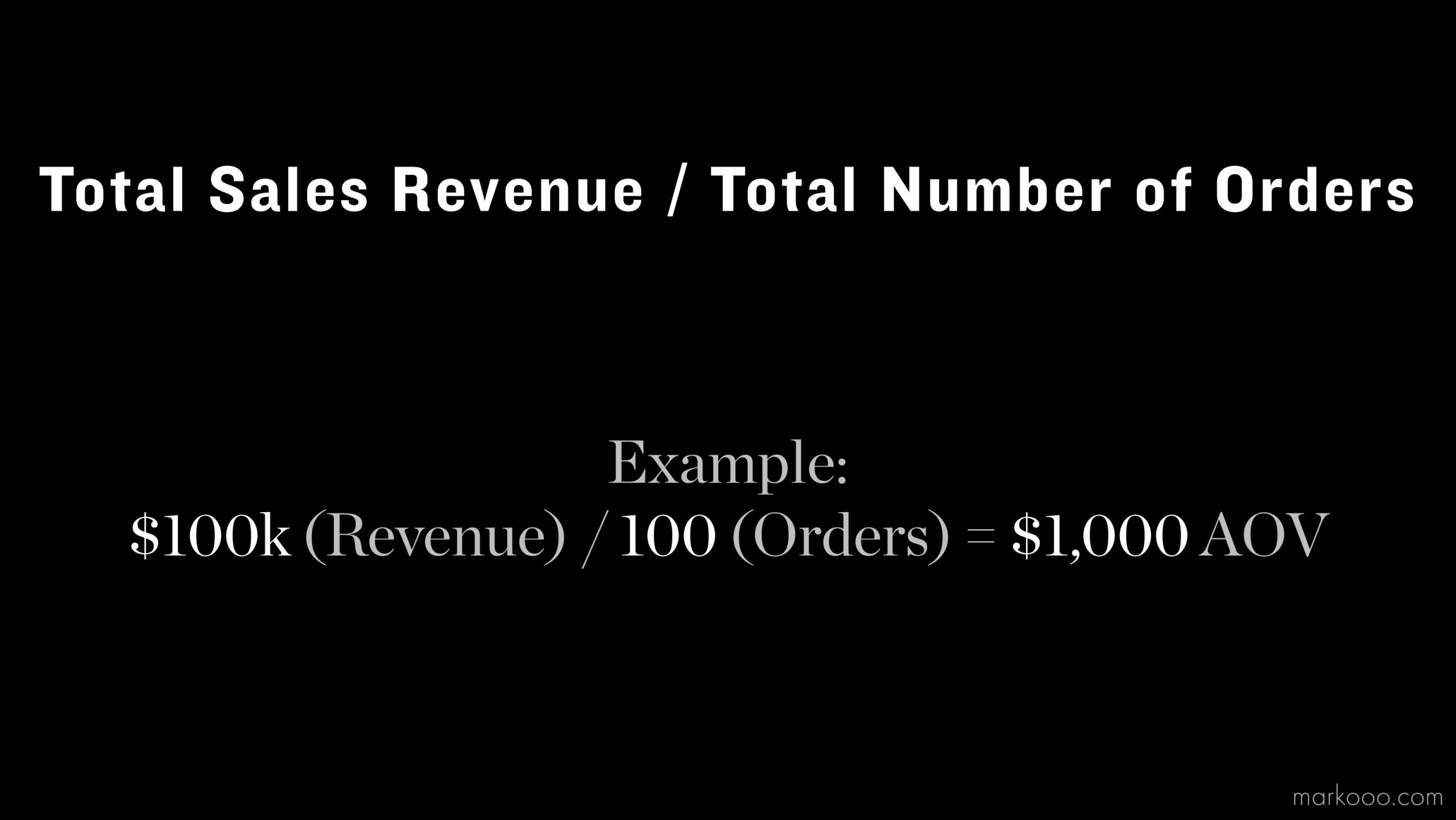
Here’s an another example:
If you sell $2,000 worth goods in twenty sales transactions your AOV would then be $100.
($2,000) / (20) = $100
AOV is one of the most critical key performance indicators for eCommerce businesses. It can be tracked by an audience, segment, or individual basis.
In the next section, we’ll talk about the importance of each use case.
But let’s first address the concept of a “good AOV” before we proceed.
The definition of a “good AOV” will depend on many factors.
- Industry
- Sales channel
- Consumer uses based on different the device
Although industry averages can be used as benchmarks, it is more productive to focus on improving AOV regardless of your position in relation to your competitors.
Let’s now discuss why AOV tracking and improvement are so important to your business’ success.
Online Shopping Behavior for Higher AOV
Online shopping behavior to get higher average order value vary.
According to shopping motivations, shopping behaviors such as shopping page visits and shopping cart additions are different across the three types of online shopper.
In simplified terms we have:
Informational (browse): They visit pages that share product information; they add products to their shopping baskets more than other two types of shoppers. If you have an online business (especially DTC business), informational shoppers can decide if your product is what they want or not.
Buyers (reviews & comparison): They read reviews from other customers and check competitors prices before deciding on a purchase; they don’t usually add products in shopping carts but add them later when they are ready to place an order. So for these type it is ideal to have a retargeting ad campaign.
Impulse (spur-of-the-moment): The urgency to make a purchase will come at any moment; they spend less time thinking and comparing; they just add a product to shopping cart when they feel like buying one. These are usually first-time shoppers.
Related shopping motivations result in different shopping behaviors which impact shopping basket abandonment rates, average order value and conversion rates.
Higher shopping page visits per session and shopping baskets additions positively impacts the first two metrics: shopping basket abandonment rate will be lower because complete orders are more likely to happen if a shopper wants to buy a product or products from your store.
For eCommerce businesses, higher average order value is directly correlated with higher conversion rates but not necessarily with shopping basket abandonment rate.
This happens because even though browse-only shoppers add products into their shopping carts, there’s a chance that they abandon their shopping sessions.
A higher shopping page visits per session and shopping carts additions positively impacts the end purchase i.e. it lowers cart abandonment rate.
To increase average order value it’s necessary to figure out which shopping motivations result in higher shopping page visits per session and shopping carts additions.
What is the purpose of tracking and improving average order value (AOV)
Average order value is one of the most important metrics for the eCommerce business because it tells us how much revenue we can expect to make.
Tracking this metric and improving its return also implies that we want to drive sales with better margin and minimize post-payment discounts or product promotions that lower margins.
As a result, any automation in an eCommerce business should not only focus on increasing the number of orders but also on maximizing average order values.
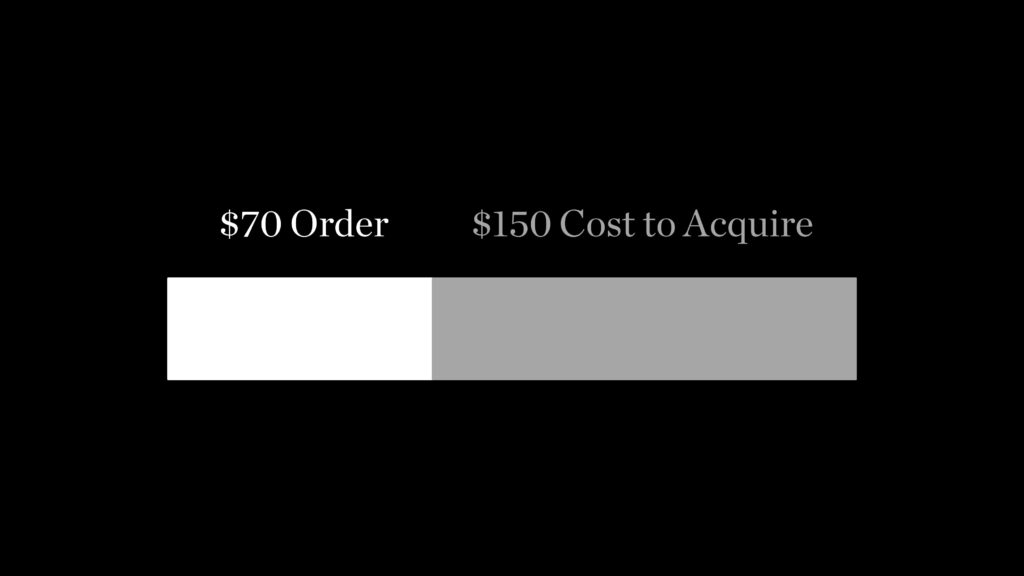
The first step to increasing your company’s return on investment is by improving the average order value.
By focusing on items that are at a higher price point, you will increase customer loyalty and sales for these products which in turn increases revenue from additional product lines sold.
There are two things we should focus on when considering the importance AOV has for your business:
- It is important to keep track of your AOV
- It is important to work continuously to improve your AOV
It is important to track and know your AOV
We mentioned that knowing your AOV will allow you to compare your brand with other brands in your industry in terms revenue generated per transaction.
Why is this important information?
It allows you to get a better understanding of your customers through a variety of methods, including knowing:
- How they shop?
- Do they make quick trips to the product pages they want, or browse the web and often make additional purchases “on-the-fly”?
- What they buy?
- What are their most frequently purchased items?
- Are they likely to purchase additional items in addition or a mix of their main purchases?
- What they are willing to spend?
- What makes them spend more than their average order value?
After you have this information, you can start to identify areas where your customers can spend more.
You can also pinpoint areas where your customers are less likely to spend beyond their usual spending limits. In the next section, we’ll go into more detail.
How important it is to constantly improve your average order value (AOV)
So the main reason to improve your AOV is quite obvious.
Your company will earn more revenue if your customers spend more per transaction. Making money and making your customers delighted is, of course, the goal.
This is how it works: If your customers spend more on each order, their lifetime value will rise even though their time with your company does not increase.
Similar to the above, increasing your customer’s AOV will mean that you make more money over the same period, even if they don’t spend as much.
Quick aside: You would like to see these metrics increase over time. But that’s another discussion.
I’ll shift gears to mention that a higher CLV is good news for retention and acquisition costs.
An increase in AOV will allow you to recover the costs of converting or keeping a customer more efficiently and economically.
You can then invest the money, time, and other resources that you have saved in your company’s various initiatives.
It’s not about making your customers spend more, but proving that there is value for them.
Why is AOV important?
Simply put, the higher your AOV, the more revenue that you can make from the same customers.
This means that you can increase revenue without increasing your marketing and sales costs by the exact same factor.
AOV optimization is another lever that marketers have to pull in order to grow their business.
You can use common ways to increase AOV and those are: upsells and cross-sells; product bundling; free shipping with a minimum order amount.
Profit and Average Order Value
Average order value, operating profit margin and ecommerce growth are tied together.
As you increase your AOV, you are able to put more effort into shopping optimization, adding new products that may increase your AOV even further.
What do these mean?
Operating profit margin is the profit made from each sale after taking out
1) cost of goods sold
2) operating expenses (which includes shopping costs).
It’s a good indicator of how profitable a business is because it takes into account both variable costs and fixed costs.
Variable costs are those that change with each item sold (such as shipping or shopping promotion expenses).
Fixed costs are those that remain constant even though we’re selling more items (such as website hosting fees or shopping cart service fees).
Three keys to increasing your average order value (AOV)
Now that we understand what is AOV and why it is important, in this section I will discuss three strategies that you can use to increase your average order value.
- AOV-based segmentation
- Marketing initiatives based on AOV
- Customer experience improvement
Each section will explain the importance of this approach to increasing your AOV and give examples from brands that have had great success with AOV-related initiatives.
1. Segment your customer group into three categories: High, Average, or Low Spenders
We’ve already mentioned that it is important to improve your AOV.
- All your customers
- Your specific customer segments
- Individual customers
It is not possible to do this by applying a universal approach. Your AOV-related marketing campaigns must be tailored to specific customers or audiences to be successful.
This is possible by segmenting your audience based on AOV.
You’ll need to start by segmenting your customers into three groups.
- High-spending customers
- Average spenders
- Low-spending customers
Pro tip: You can define “high” or “low” spending customers in your own way, but it is more effective to use the standard deviations of your actual AOV as a guidepost.
Once you have the basic segments in place, you can further segment each section based on additional data (e.g. their purchase frequency or type of product purchased, etc.).
Segmenting customers using AOV-related data can help you create marketing campaigns, initiatives, and offers for your target market.
You can then provide dynamic content, relevant offers and a sufficient trade-off to make your customers more likely to spend more during their next transaction.
2. AOV-based marketing strategies now can be used
Once your audience has been segmented according to their AOV, and any other relevant information, you can start creating highly relevant and highly enticing offers for each audience.
I’ll be discussing the best offers you can make to your customers and presenting examples of brands who have taken these strategies to new heights.
1st Average Order Value Marketing Strategy is Upselling
Sell a relevant product that is well worth the extra cost.
Upselling refers to the act of showing customers similar products that are more valuable than one another in order to encourage them to make a purchase.
Best Buy, for example, ensures that people looking to buy a new TV see all the options available when they are comparing models.
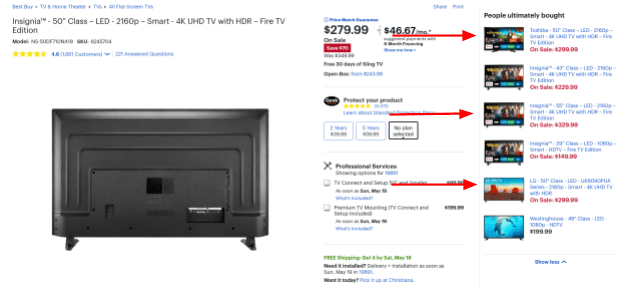
We have stressed throughout this article the importance of relevancy and perceived value in making upsells.
It is crucial that you are recommending products that meet the needs and expectations of your customer at each stage of their buyer’s journey.
You can see from the example that many of these televisions are more expensive and offer more value than the original item. This is upselling 101.
A customer might be willing to pay $279 for a 50-inch television, but they may also be interested in an additional $50 to get another five inches.
This is just the beginning of personalizing upsell offers. Best Buy needs to know more information about their customers to be able to personalize upsell offers.
For example, they need to know what the customer wants in a TV and how much they are willing to spend.
You might offer upsell offers on product pages. However, similar promotions may be offered on pages that your customers will see later in their buyer’s journey.
Mixbook allows customers to edit and add to their carts for a specified period after they have made their purchase.
It doesn’t matter what your upsell offer looks like or where it is displayed.
What matters is that the offer is relevant to your customers and worth the extra cost.
Although it is unlikely that you will be able to double the customer’s AOV just by selling them products outside their price range, your goal is to get them spending more each time they buy.
2nd Average Order Value Marketing Strategy is Cross selling
Show supplementary or “frequently purchased together” products.
Cross-selling refers to the promotion of products and services that complement the main product a customer is interested in.
Amazon‘s section “Frequently purchased together” is perhaps the most well-known example of cross-sell offers.
Cross-selling offers are designed to add value to the customer’s initial experience with the product.
Amazon points customers looking for a new gaming console to a popular game and a separate controller. Neither of these can be used without the actual system.
Ocado, an online grocery store, follows a similar approach. It offers supplementary foods that complement the initial purchase.
Imagine a customer going to buy the bagels above and seeing the cream cheese on sale. The customer decides to give cream cheese a shot and loves it. They buy cream cheese whenever they buy bagels – increasing their AOV by a lot.
Cross-selling is not the best strategy, since you should always offer products that are cheaper than the original. However, loss-leaders can be a great way to encourage customers to buy more expensive products in the future.
Cross-selling should not be confused with upselling. Your main goal when offering cross-sell options should be to provide added value for the customer. This includes knowing the customer’s plans for using the “main” product and what products they might be interested in.
3rd Average Order Value Marketing Strategy is Incentive
Incorporate purchasing thresholds and loyalty programs.
The AOV-related initiatives and offers we have discussed so far were focused on getting customers into specific products.
It’s possible to make your customers spend more by offering them incentives.
Let’s start with purchasing thresholds.
Some discounts are offered by purchasing thresholds. Once a customer’s order amount reaches a certain level, it will be removed. This offer typically involves a dollar or percentage reduction on the total order.
Mobovida was capable of increasing their overall AOV by an astounding 15.81% by simply adding a variable shipping calculator.
Your loyalty programs can help you increase your AOV in two ways.
One, loyalty point holders will be more likely to purchase additional items, make larger purchases and take on the “challenges” you set for them.
Starbucks is the king when it comes to loyalty program incentives.
Customers who have earned their rewards can also earn an opportunity for companies to increase their customer’s AOV.
A customer who buys regular coffee might get a free specialty beverage. If they love it, they may end up buying it more often.
Even a single “special occasion” purchase can lead to an increase in AOV over time – both for the individual and the entire audience.
The data provides hard evidence of how loyalty programs affect AOV.
Loyalty programs have an average increase in AOV of 13.71%.
Some loyalty programs helped companies increase their AOV up to 75% in some cases. You can see some of Success Stories and their improvements in AOV and net profit.
Pro tip: You should not only sell more, but also offer cross-sells and upsells to customers to increase their order value. It’s more about making an offer that is so compelling that a customer will spend more money to get it.
3. Enhance the customer experience
When improving AOV, the final area you should focus on is your customer experience.
Your customers will be more likely to use your website if they find it easy and enjoyable to navigate.
This will enable them to view your products and offers frequently, which can lead to more sales when they interact.
Your customers may not want to look around at what you have to offer if they find it too difficult to navigate your website.
While they might be able tolerate your site long enough to make an important purchase on it, they will not make any more purchases while they are there.
10 Tips to Increase your Average Order Value
These 10 tips I think are nice addon to what we have covered so far, especially knowing why optimizing for higher-order values is a smart investment.
Let’s now look at the best 10 ways to increase your average orders value.
1. Add a discounted up-sell after customer completes the order
As mentioned above, customers can increase their AOV with upsells. Businesses should not send customers thank-you pages or confirmation pages after they checkout. Instead, they should upsell.
Let’s suppose that a customer buys a $100 product. Now, they are about to leave our site.
Instead of sending them to a thank you page, redirect them towards an upsell website. Offer a product related to the one that they just bought.
They will receive 30% discount if they purchase the additional product immediately.
This upsell will be bought by most buyers, and your AOV will increase automatically.
2. Take an Analytical Perspective to AOV
Instead of starting with a tool or tactic, do your homework first.
First, take a look at the top-selling products you have and dig deeper.
- What are customers buying?
- What are their uses?
Next, consider how subscriptions, increased quantities or additional products can be used to help.
Optimizing your AOV, just like Conversion Rate Optimization is more than a single website update.
If you want to have a high AOV, you need to consider everything, from shipping options to loading times to merchandising.
Although it can be tempting just to try everything to increase AOV, my recommendation is to take a systematic analytical approach.
An example is to segment your customers by the amount they spend. Then target customers who spend less on cross-selling or who are loyal with loyalty programs.
If that fails, you can try another method such as free shipping.
You should not try all of the strategies at once as it is more difficult to determine which method is best for raising your AOV.
3. For free shipping, use a minimum dollar threshold
Increasing the minimum order amount customers need to hit in order to get free shipping is a great way to increase AOV.
We are all consumers. So we all have tried to find $10 more items so that we don’t have to pay shipping. Although it’s small, it is a good thing.
If customers are close to the threshold for free delivery or reduced shipping, a pop-up will inform them. Customers often add more items to their carts to qualify for free or reduced delivery.
This works best if customers are informed about how much shipping costs and how far they have fallen from the threshold.
You can download a plugin to show users how they can get free shipping if they spend just a bit more.
If a user has purchased $35 products, the message will tell them to spend $15 more to get free shipping.
4. Cross-Sell Similar Products at Checkout
Although this tip might seem obvious, there are two ways to cross-sell.
Cross-selling is about offering items that add value to your customer’s experience, not unnecessary items.
Cross-selling must be seen by the customer as advice.
For example, what shirts go well with your new suit? If you are able to give a reliable answer, your AOV may increase.
5. Bundle Products and Discounts
Bundling is the best way to increase my clients’ average order value. Bundling products that meet customer needs and offer great value is the key.
You can increase your AOV by bundling related products.
Customers will be more willing to spend if they feel they are getting a better deal.
Clear categories are essential for an ecommerce store. However, it is important to include related products from other categories.
Important: You will feel the urge to offer discounted items. This will only cause AOV to fall. Discount in a bundle.
Instead of dropping $10 on a product, drop $7 on it. Take two products and bundle them together for $14.
You can still get a 30% discount on your original product but your AOV will rise instead of decrease.
6. Offer a higher-priced payment plan
Credit card companies know this for decades: Customers are more willing to spend if they don’t have the obligation to pay upfront.
You can offer a payment plan to purchase high-ticket items for a lower total cost than what you pay in full.
As the total price rises, so will your conversion. However, your AOV will also increase.
7. Have an upsell and cross sell email follow-up sequence
Cross-selling and Up-selling are about finding the perfect balance between prioritizing sales and adding value.
If you’re too pushy, it can distract your customers. You could lose the chance to increase your income if you don’t take action.
In the email follow-up sequence, include upsells – specifically the confirmation emails.
To avoid interfering in the original sale, it is not included with the purchase. It will be sent once the purchase has been completed.
It’s like saying “Thank You for Buying ABC!” You can now buy XYZ at 10% off because of your recent purchase.
To set up add-on email addresses, you will only spend a fraction of the cost. This will make it easy for anyone who wants to get in the green.
You should use the data that you have to personalize these cross- and up-sell emails to each customer.
You can personalize future purchases using the data you collect from customers.
8. Market to a High-Value Buyers
Marketing strategically is the best way to increase your AOV. Make sure your products are as relevant as possible to your market base.
If you spend $3,000 on an ad to get 3,000 customers interested in one product, your AOV will be lower than if you spend $3,000 on an ad to reach customers likely to be interested in all of your offerings.
9. Establish trust and authority with your target market
The direct relationship between customer trust, and spending on your website is real eCommerce flow.
They will ask “Are these guys legit?” If they have some sense of skepticism they will move on. So, creating a trustworthy brand is essential.
That’s why when I develop a Clarity Blueprint for clients, one of the fundamental part is having a strategy to build a brand credibility the right way.
It is a direct method to increase AOV through building trust and authority in the brand.
Your brand’s trustworthiness will make it more likely that people will purchase more expensive items from you.
This trust gap can be bridged by third-party reviews, but nothing beats your content, mission and brand awareness on multiple online channels.
10. Add-Ons for Downsell Items
While we often talk about cross- and upselling in the ecommerce industry, what about downselling?
A $20 standard tripwire product should be used as a first step. After that, you can offer a more expensive upsell.
However, I have found the downsell process to be just as effective.
How many times have you spent more than $50 on groceries and then bought a candy bar at checkout for only another dollar?
These small things can add up. Even $5 increase for every order will compound your net profit overtime.
Bonus Tips for Increased AOV
After writing an entire article, I was thinking “What else can I add that is important” and there are three things that I have noticed that my clients struggle regarding AOV and I will address them here.
The Best Traffic Source for More Online Sales and Higher AOV
It’s no secret that Google shopping ads and SEO are a good source of shopping traffic for most online sellers.
SEO is generally more predictable, so it helps build a strong brand image and customer trust – both of which lead directly to higher conversion rates on shopping campaigns.
We have less control over the shopping traffic we get from Google Ads, than we do over organic search traffic (i.e., website rankings).
But Google Ads can be highly successful in driving sales if you know how to optimize ad text and product groups to best present your products.
Let’s take a look at some ways that shopping ads can increase average order value (AOV) for your business:
There are two main reasons why shopping ads perform better than other paid sources when it comes to shopping traffic.
Shopping ads are based on keywords that shoppers actually use, shopping campaigns tend to have less competition and therefore a much higher conversion rate than other kinds of PPC marketing.
Another advantage is that shopping traffic tends to convert at higher rates than search traffic.
So, shopping campaigns can be highly profitable, while still spending less per click.
When you combine high shopping ad click-through rate with low cost-per-click rates, it presents an attractive opportunity for sellers who want more profit without raising their advertising costs.
Of course, you should track your Google Ads and SEO performance with Google Analytics to determine which channels are working best for your business.
When you combine Google Ads, SEO and tracking using Google Analytics you will have a great overview of buying behaviors and buying patterns.
When you know that, then you’ll be able to distinguish high-margin sales, low-margin sales and increase in sales value.
Why would the average order value drop?
A great product that attracts many customers is not always enough.
As mentioned multiple times throughout the article, a company’s average order value (AOV) is a key indicator of the health of their business.
It can also be an indication of how well they are doing in terms of customer satisfaction, and how much profit they are making per sale. So why would AOV drop?
There could be many reasons for this.
For example, when an increase in the average order size causes an overall drop in revenue, it’s likely due to a shift in customer base rather than new customers.
It may also be due to discounting and the promotion of lower priced products.
An apparent decrease in revenue could be due to a decrease in demand for higher priced products or services.
What is the best Upsell strategy to increase average order value?
Upsell strategy is important because it increases average order value and customer lifetime value. We can use Post-Purchase Discounted Upsell or other ways to increase AOV.
As mentioned multiple times throughout the article, an upsell is when a user makes another purchase, after making a first purchase.
Use upsell strategies to increase the time you receive products. Offer a discount or free shipping or a free gift on purchase of an extra product from your site.
This increases the incentive to buy more products because you will be receiving something new in return.
Consider adding new products that will upsell another product on your site. This way you will get more customers to sign up for your newsletter and make more purchases on your site.
If you have an offer that has already been running, add a new item to that offer list.
For example, if you have an offer for a free eBook or a free weekly video, add an additional item to it such as a free e-book and an additional video.
Yes, that includes eCommerce websites.
Having a complimentary e-product is an awesome way to increase average order value and have a success in post-purchase upsells.
The trickiest part is that customers will have to be convinced that the AOV increase from an AOV adjustment is worth it.
Think of all your AOV opportunities from every possible point of contact with the customer.
How can you change the upsell value in ways that will trigger that upsell?
This can be done by small adjustments, a few dollars here and there, or something more drastic.
One easy way to do it is by adding a one-click post-purchase upsell.
This improves user experience and usually you will be able to find a plugin if you use Shopify or Woocommerce.
Conclusion
One thing to note as we wrap up: It is important that you don’t sacrifice any other KPIs when working to improve your AOV.
This means that the goal is not to increase your AOV, but to generate more revenue by increasing AOV.
It all boils down to what value you offer your customers. If your offer is perceived as valuable by customers, they will almost always accept any offer that you make.
Now go ahead and delight your customers with relevant products which would bring smile to their and your face.


